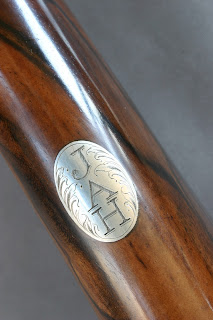One of the things that most engravers learn early in their career is lettering. Lettering is mechanical as well as being an art. When engraving block letters it is more mechanical for the layout and cutting. Skill and control of the tool is involved in the cutting the letters. All the letters need to be cut the same height with the bottoms of all the letters level and on a straight line. Letters like the O will need to be so very slightly above and below the lines. Letters like the A will need to be slightly higher than the top line. Other letters that this applies to are the C,G,J,M,N,O,U,V, and W. If this is not done then these letters appear to be smaller.
When the engraver does script, old English, leaf letters, scroll letters, etc. this is where the artistic touches come into play. Quite often the engraver can add touches of art to these styles.
The gravers used for lettering are square, flat, round and liners. The type of graver to be used will depend upon the style of lettering. Square gravers can be used for all styles of lettering. The flat can be used for script. The flat graver can give a very fine line to a wide beauty cut. The round gravers and also flat can be used for the block styles of letters. The liners would be for lettering styles that would be filled in or with multiple lines like that of a ribbon style.
There are so many variations to lettering. The letters can be cut with outlines and then filled in with vertical lines, horizontal lines, dots, or combinations. Shading lines can be added to the outside, usually to the bottom and right side. The shading depends upon the artist engraver. The letters can also be inlaid with gold which make them stand out on a blued gun.
Monograms are usually very artistic. Between the design, layout and engraving, monograms consume a lot of time to do. A monogram consists usually of three initials. The last name (surname) is placed in the center and larger than the other two initials. An example would be JBR for James Russell Blair.
I have always enjoyed chasing out or engraving the lettering on old English shotguns and double rifles. The lettering was done with a minimum of cuts. To me it is a very pleasing slanted Roman style. It is cut quickly and precise.
There are some rules that do need to be followed. When cutting script the engraver should follow the up and down strokes, from thin to thick lines. The use of power assists engravers can reduce or completely eliminate having to do the up and down strokes. When cutting a Roman style with serif, the serif should be cut first. This establishes the top and bottoms of the letters. These are only a few of the rules. Like all art work after learning the rules many can be broken.
The design (style) and layout can be accomplished many ways. The layout can be done by scribing guide lines on the the surface to be engraved. The computer can be used to do the layout and then printed onto a transfer. The printed transfer is then transferred onto the surface to be engraved. A pantograph can be used. Cronite Company pantographs were made to be used in the engraved stationary field. The pantographs are used to scribe the letters onto the surface then the engraver engraves the scribed letter. This eliminated having to use guide lines.
The cost of lettering is usually straight forward, charging per character (letter). The size and style is what will establish the cost. The only variable may be where on the object and the hardness of the material to be engraved. Monograms will cost more because of the time involved in design and engraving. Gold inlaid letters add considerably to the cost.
This is just a very general overview. I probably have left you with more questions than answers. Whole books have been written on the engraved letter. One of the most important points to remember when engraving letters is spelling , double check and then check again. I welcome questions and comments.











No comments:
Post a Comment